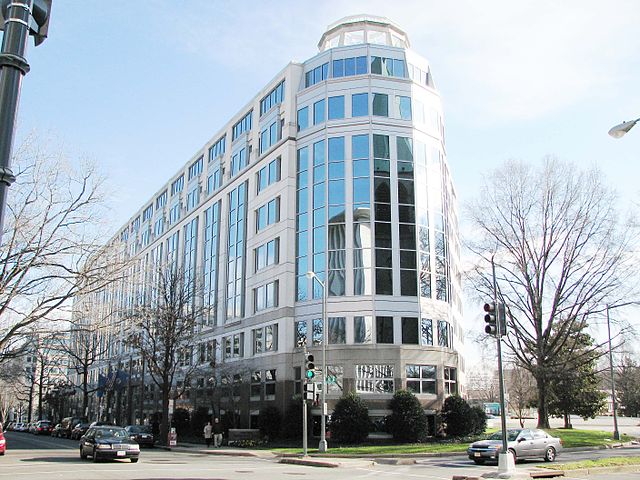“A successful redesign has the potential to avoid any harmful effect of a Section 337 case on a respondent found in violation; however, a failed attempt to redesign an infringing product—and obtain timely clearance of that product—can bring significant, negative business consequences.”

“The USITC in Washington DC.” Licensed under CC BY-SA 3.0.
Investigations brought under 19 U.S.C. § 1337, commonly known as “Section 337” cases, at the United States International Trade Commission (ITC) have become a go-to enforcement option for patent owners seeking fast, injunction-type relief against infringing imports. It is well known that the ITC issues powerful remedial orders, including (1) exclusion orders, which order United States Customs and Border Protection (Customs or CBP) to exclude infringing imports imported by Respondents or, in some cases, third parties, and (2) cease-and-desist orders, which order Respondents not to import or sell infringing, imported products in the United States. Because ITC remedial orders are broadly written to cover even unadjudicated products that infringe the subject patents, and because such orders are only prospective in nature, it is critical for ITC litigants and their attorneys to understand the available procedures to adjudicate redesigned products.
Adjudication Before Issuance of ITC Remedial Orders
As a respondent in an ITC action considering a redesign, or as a complainant assessing a respondent’s potential to come up with a redesign, the first consideration is whether the redesign will be introduced during the pendency of the ITC case, or whether it will be introduced thereafter. If introduced properly, it can be beneficial to a respondent to obtain an adjudication on a redesign during the Section 337 case, to obtain certainty regarding how the redesign will be treated if any remedial order issues. Even if the redesign is found to infringe, the respondent that introduced it is arguably in a far better position to know that before the issuance of remedial orders. On the other hand, proving a violation of Section 337 is difficult, and involves prevailing on many issues other than infringement. Some respondents may not want to expend the resources necessary to develop a redesign, or they may not want to “tip their hand” by introducing that redesign before it is absolutely necessary. The considerations presented in this section should help Section 337 litigants make an informed decision whether introduction of a redesign during the ITC action is preferable to doing so after remedial orders issue.
As an initial matter, it is important to note that, in contrast to district court, if a violation is found and remedial orders issue, a redesign will (1) will be presumed to infringe by Customs unless and until the importer demonstrates that it does not infringe; and (2) will be covered by an ITC remedial order if it is later found to infringe. Hyundai Elecs. Indus. Co. v. Int’l Trade Comm’n, 899 F.2d 1204, 1210 (Fed. Cir. 1990) (explaining that, where an exclusion order issues, the burden of establishing non-infringement “effectively shifts to would-be importers[.]”). It is, therefore, imperative that a respondent that seeks to introduce a redesign do so in a manner that results in an adjudication of infringement.
To assure that the ITC will adjudicate a respondent’s redesigned product, the respondent should import the product and provide sufficient discovery regarding that product—including documents, expert opinions, and contentions—to allow for a thorough consideration and adjudication of that product by the Commission. See Human Milk Oligosaccharides & Methods of Producing the Same, Inv. No. 337-TA-1120, Comm’n Op. at 18-19 (June 8, 2020) (setting forth factors relevant to whether a redesign will be adjudicated); Certain Digit. Video Receivers & Hardware & Software Components Thereof, Inv. No. 337-TA-1001 Comm’n Op. at 2 (Dec. 6, 2017) (vacating an infringement determination because the design at issue was “too hypothetical to adjudicate at this time”). To ensure that a redesign is adjudicated, the best course is to provide thorough discovery and present an affirmative case of non-infringement. Though some may bristle at the notion that a respondent be required to prove non-infringement, where respondents have presented such affirmative evidence, complainants have recently been unable to avoid a non-infringement determination by claiming the redesign is not accused. See Certain Elec. Digit. Media Devices & Components Thereof, Inv. No. 337-TA-796, Comm’n Op. at 104 (Sept. 6, 2013) (“When confronted with [respondent]’s evidence of noninfringement, [complainant] had an obligation to either present evidence of infringement or withdraw its allegations concerning these products, but it did neither.”).
Adjudication After Issuance of ITC Remedial Orders
As alluded to above, it is often not feasible or desirable to introduce a redesign during pendency of a Section 337 case. In those cases, a respondent or other importer potentially subject to an exclusion order (non-respondents can be excluded from importation where the ITC issues a general, as opposed to a limited, exclusion order) has multiple options for obtaining an adjudication regarding its redesign. And potential importers face a daunting number of variables in choosing among these options, including current inventory, whether the importer is subject to the penalties associated with violating a cease-and-desist order, lead times, seasonal demands, and more. As noted above, unadjudicated products will generally be excluded from importation until the product is found to be non-infringing. What is more, where a respondent found in violation is subject to a cease-and-desist order, the continued sale or support of infringing products can subject that party to significant civil penalties. 19 U.S.C. § 1337(g).
This section seeks to provide information that will be useful to such importers in determining the best option for adjudication of a redesigned product. The two available forums for obtaining such an adjudication are (1) Customs and (2) the ITC. Before assessing the procedures available, it is important to note that findings made by Customs are not binding on the ITC, whereas most findings of the ITC (except for advisory opinions, discussed below) are binding on Customs. District court findings, while not addressed specifically in this article, are binding under ordinary principles of res judicata. See Vastfame v. Int’l Trade Comm’n, 386 F.3d 1108, 1115 n.2 (Fed. Cir. 2004).
Adjudication by Customs
CBP’s ability to adjudicate redesigns stems from its authority and obligation to enforce exclusion orders. For many importers, the exclusion order presents an immediate business problem: they are unable to import products desired by consumers. Adjudications by Customs are generally the fastest way to solve that problem. To make such rulings, CBP follows procedures detailed by regulation in 19 C.F.R. § 177 (“Part 177”). Rulings under Part 177 are not tailor-made to adjudicate infringement; in fact, such rulings were traditionally issued to determine proper classification of imports under the Harmonized Tariff System of the United States. Over the years, Customs has adapted its procedures under the rule to allow for efficient adjudication of redesigned products and other products potentially subject to exclusion under ITC exclusion orders.
The most important change made to its traditional practice is that Customs now encourages parties seeking rulings under Part 177 to offer the ITC complainant/patentee the opportunity to participate in the proceeding. This represents a dramatic improvement over prior Customs practices, whereby the process was conducted ex parte, thereby depriving Customs of the benefits of an adversary proceeding. Where Customs conducts an inter partes proceeding to make a Part 177 ruling, Customs requires that the parties sign an NDA and agree to a briefing schedule. Generally, Customs targets issuing Part 177 rulings within approximately 2-4 months from the initial ruling request. In some instances, therefore, an importer can obtain a Customs ruling that is effective before, or shortly after, the end of the 60-day Presidential review period provided for in 19 U.S.C. § 1337(j).
Potential importers should also consider the downsides to Part 177 rulings. One main drawback is that such rulings could lead to a separate action at the ITC, which could lead to an inconsistent result. That inconsistency is dangerous to an importer where Customs finds non-infringement, and the ITC finds infringement, because the importation permitted by Customs could result in penalties for violation of an ITC cease-and-desist order. A second drawback is that Part 177 rulings are not appealable, which can be a source of frustration for both complainants and respondents. Funai Elec. et al v U.S. et al 645 F.Supp.2d 1351 (Ct. Int’l Trade 2009) (dismissing a complaint filed by a patentee challenging a part 177 ruling).
Adjudication by the ITC
The ITC also has procedures available to adjudicate infringement of redesigns as it relates to ITC remedial orders. The ITC’s procedures for adjudicating redesigns are somewhat more flexible, in that at least some procedures can be initiated by either the complainant or a prospective importer. Obtaining an adjudication from the ITC also has the benefit of conclusively determining whether importation or sale of the product constitutes a violation of a cease-and-desist order, removing doubt about penalties that may be incurred for continued importation and sale. This section presents the various procedures available at the ITC, along with the benefits and drawbacks thereof.
The widest-ranging procedure for determining infringement of a redesign (or other product) at the ITC is an enforcement proceeding conducted pursuant to 19 C.F.R. § 210.75. Enforcement proceedings are proceedings initiated by a complainant to determine violation of a Commission remedial order. Typically, such proceedings are initiated in conjunction with cease-and-desist orders, with a complainant requesting that civil penalties be imposed on the violating party. 19 U.S.C. § 1337(f). Enforcement proceedings are conducted under the general authority of the ITC to conduct investigations, and they are therefore subject to the procedural requirements of Section 337, including the right to appeal enforcement determinations. Vastfame v. Int’l Trade Comm’n. Enforcement proceedings typically take a year or more to complete.
Modification proceedings are a relatively new means to obtain binding, appealable adjudications on a redesigned (or other unadjudicated) product. Such proceedings are conducted pursuant to 19 C.F.R. § 210.76. In a notice issued in 2015, the Commission made clear that modification proceedings provide a vehicle to adjudicate infringement. That notice was issued to clarify the options for both importers and intellectual property rights holders regarding obtaining “timely, transparent, and binding decisions on whether new and redesigned products are covered by remedial orders” issued by the ITC. Id. The notice provided that the Commission would complete modification proceedings pursuant to the following timelines: (1) for pure questions of law, within 60-90 days; (2) for proceedings involving minimal fact-finding, within 90-180 days; and (3) for proceedings requiring extensive fact-finding, within 6-9 months from institution.
The final procedure available to adjudicate redesigns is an advisory opinion. See 19 C.F.R. § 210.79. Advisory opinions are conducted according to the same timeline as modification proceedings, but they are not binding on Customs nor appealable to the Federal Circuit. Customs, however, has historically followed the ITC’s rulings issued in advisory opinions. Accordingly, advisory opinion proceedings provide a one-shot means to adjudicate infringement of a redesign under a known timeline.
Weigh Your Options Carefully
Respondents and complainants should carefully consider the possibility of a redesign being developed in any ITC case. A successful redesign has the potential to avoid any harmful effect of a Section 337 case on a respondent found in violation; however, a failed attempt to redesign an infringing product—and obtain timely clearance of that product—can bring significant, negative business consequences. Before deciding on a strategy to obtain an adjudication of a redesign, an importer should consider the above options in conjunction with the business and market dynamics affecting the importer’s ability to, for example, weather a period in which importations of products are not permitted.

![[IPWatchdog Logo]](https://ipwatchdog.com/wp-content/themes/IPWatchdog%20-%202023/assets/images/temp/logo-small@2x.png)

![[Advertisement]](https://ipwatchdog.com/wp-content/uploads/2024/04/Patent-Litigation-Masters-2024-sidebar-early-bird-ends-Apr-21-last-chance-700x500-1.jpg)

![[Advertisement]](https://ipwatchdog.com/wp-content/uploads/2021/12/WEBINAR-336-x-280-px.png)
![[Advertisement]](https://ipwatchdog.com/wp-content/uploads/2021/12/2021-Patent-Practice-on-Demand-recorded-Feb-2021-336-x-280.jpg)
![[Advertisement]](https://ipwatchdog.com/wp-content/uploads/2021/12/Ad-4-The-Invent-Patent-System™.png)







Join the Discussion
No comments yet.